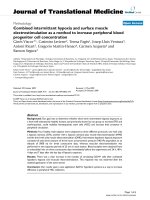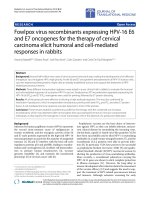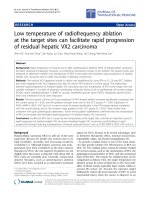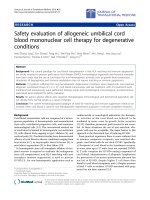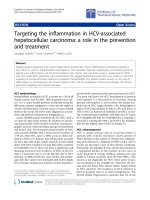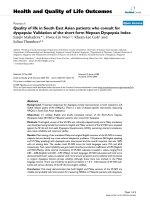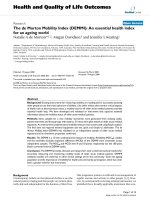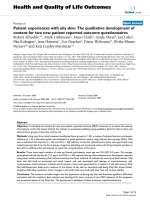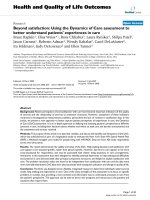báo cáo hóa học:" Low temperature fired Ni-Cu-Zn ferrite nanoparticles through auto combustion method for multilayer chip inductor applications" pptx
Bạn đang xem bản rút gọn của tài liệu. Xem và tải ngay bản đầy đủ của tài liệu tại đây (1010.31 KB, 31 trang )
This Provisional PDF corresponds to the article as it appeared upon acceptance. Fully formatted
PDF and full text (HTML) versions will be made available soon.
Low temperature fired Ni-Cu-Zn ferrite nanoparticles through auto combustion
method for multilayer chip inductor applications
Nanoscale Research Letters 2012, 7:112 doi:10.1186/1556-276X-7-112
Khalid MUJASAM Batoo ()
Mohammed Shahnawaze Ansari ()
ISSN 1556-276X
Article type Nano Express
Submission date 27 September 2011
Acceptance date 8 February 2012
Publication date 8 February 2012
Article URL />This peer-reviewed article was published immediately upon acceptance. It can be downloaded,
printed and distributed freely for any purposes (see copyright notice below).
Articles in Nanoscale Research Letters are listed in PubMed and archived at PubMed Central.
For information about publishing your research in Nanoscale Research Letters go to
/>For information about other SpringerOpen publications go to
Nanoscale Research Letters
© 2012 Batoo and Ansari ; licensee Springer.
This is an open access article distributed under the terms of the Creative Commons Attribution License ( />which permits unrestricted use, distribution, and reproduction in any medium, provided the original work is properly cited.
1
Low temperature-fired Ni-Cu-Zn ferrite nanoparticles through auto-
combustion method for multilayer chip inductor applications
Khalid Mujasam Batoo*
1
and Mohammad Shahnawaze Ansari
2
1
King Abdullah Institute for Nanotechnology, King Saud University, PO Box 2460,
Riyadh, 11451, Kingdom of Saudi Arabia
2
Centre of Nanotechnology, King Abdulaziz University, PO Box 80216, Jeddah, 21589,
Kingdom of Saudi Arabia
*Corresponding author:
Email addresses:
KMB:
MSA:
Abstract
Ferrite nanoparticles of basic composition Ni
0.7−x
Zn
x
Cu
0.3
Fe
2
O
4
(0.0 ≤ x ≤ 0.2, x = 0.05)
were synthesized through auto-combustion method and were characterized for structural
properties using X-ray diffraction [XRD], scanning electron microscopy, transmission
electron microscopy, and Fourier transform infrared spectroscopy [FT-IR]. XRD analysis
of the powder samples sintered at 600°C for 4 h showed the cubic spinel structure for
ferrites with a narrow size distribution from 28 to 32 nm. FT-IR showed two absorption
bands (v
1
and v
2
) that are attributed to the stretching vibration of tetrahedral and
octahedral sites. The effect of Zn doping on the electrical properties was studied using
dielectric and impedance spectroscopy at room temperature. The dielectric parameters (ε′,
ε″, tanδ, and
σ
ac
) show their maximum value for 10% Zn doping. The dielectric constant
and loss tangent decrease with increasing frequency of the applied field. The results are
explained in the light of dielectric polarization which is similar to the conduction
phenomenon. The complex impedance shows that the conduction process in grown
nanoparticles takes place predominantly through grain boundary volume.
Keywords: nanoparticles; ferrites; dielectric constant; ac conductivity; impedance
spectroscopy.
PACS: 75.50.Gg; 78.20; 77.22.Gm.
Introduction
2
The study of ferrites has attracted immense attention of the scientific community because
of their novel properties and technological applications especially when the size of the
particles approaches to nanometer scale. More novel electrical and magnetic behaviors
have been observed in comparison with their bulk counterpart [1, 2]. In general, the
transport properties of the nanomaterials are predominantly controlled by the grain
boundaries than by the grain itself [3]. Due to this reason, the magnetic materials have
explored a wide range of applications and thus are replacing conventional materials.
In the last two decades, latest advancement in wireless technology has explored the area
of real-time communication. Internet-accessible cell phones and high-speed wireless local
area network are the best examples of this technology. The core of these systems is based
on a radio frequency [RF] circuit consisting of transmission and receiving circuit blocks
required in signal amplification, filtering, and modulation that in turn require hundreds of
passive chip components such as capacitors and inductors. Inductors adapted to RF
circuits of mobile devices are mostly multilayer chip inductors [MLCIs] and microspiral
inductors. MLCIs were developed in the 1980s by thick film printing and co-firing
technologies using low temperature-sintered Ni-Cu-Zn ferrite and Ag. Recently, Ni-Cu-
Zn ferrites have been developed to meet a demand for miniaturization of electronic
components [4, 5]. The ferrite powder needs to be sintered below 950°C in order to co-
heat with silver internal electrodes (T
m
approximately 962°C) and should have low
dielectric constants for MLCI application. Materials with high permeability are also
required for reducing the number of layers in MLCIs and for realizing the better
miniaturization [6]. Further, ferrite nanoparticles are commercially important for several
applications such as in electromagnetic devices operating at radio frequencies where the
superparamagnetic [SPM] properties have a strong influence in enhancing their quality of
applications [7-9]. Nanoparticles of these materials exhibit interesting phase transitions
from SPM state to ferri/ferromagnetic state or vice versa with a variation of temperature
depending on their sizes. In this ferrite nanoparticle system, the Cu content of the
compositions was kept constant at 30 at.% of the A site (AB
2
O
4
spinel); nonmagnetic
Zn
2+
ions occupy the tetrahedral A sites, replacing Fe
3+
ions, which eventually go to
octahedral B sites. Hence, zinc cations magnetically dilute the system by making the A-B
exchange interaction relatively weaker. This weaker coupling reduces the anisotropy
energy of the system, which facilitates the onset of SPM relaxation in bigger size
particles even at room temperature. Many reports are available in the literature on Ni-Cu
ferrites where people have reported various properties of the studied ferrite material in
bulk as well as in nanoscale form. Chakrabarti et al. [10] studied the magnetic properties
of nanocrystalline Ni
0.2
Zn
0.6
Cu
0.2
Fe
2
O
4
prepared using a chemical route method, and they
reported that below 80 K, the nanoparticles exhibit superparamagnetism, and the
saturation magnetization increases with increasing particle size. Seong et al. [11]
investigated the structural and electrical properties of Cu-substituted Ni-Zn ferrites, and
they have reported that the alternating current [ac] conductivity increases with increasing
temperature of the sample and frequency of the applied field. Roy et al. [12] reported the
effect of Mg substitution on electromagnetic properties of (Ni
0.25
Cu
0.20
Zn
0.55
)Fe
2
O
4
ferrite
prepared through auto-combustion method, and they found that the permeability and ac
resistivity increased while the magnetic loss decreased with the progressive substitution.
Jadhav et al. [13] reported the structural, electrical, and magnetic properties of Ni-Cu-Zn
3
ferrite synthesized by citrate precursor method, and they reported that the dielectric
properties (ε′ and tanδ) decreases with increasing frequency of the applied field. They
further report that the maximum value of the saturation magnetization was found for 20%
Cu doping.
However, as per our best search, we have not found any detailed report in the literature
on the dielectric and impedance properties of Zn-doped Ni
0.7−x
Cu
0.3
Fe
2
O
4
ferrite
nanoparticles. Therefore, keeping in view the high demand and importance of magnetic
ferrite nanoparticles, we report in this paper the effect of Zn doping on the structural,
cationic distribution, and conductivity properties of nanocrystalline Ni-Cu-Zn ferrites.
Experimental details
Material preparation
Nanoparticles of Ni
0.7−x
Zn
x
Cu
0.3
Fe
2
O
4
(0.0 ≤ x ≤ 0.2, x = 0.05) were prepared by auto-
combustion method using ‘AR’ grade Ni(NO
3
)
2
.6H
2
O, CuCl, Zn(NO
3
)
2
.6H
2
O, and
Fe(NO
3
)
2
.9H
2
O as raw materials. The stoichiometric mixtures of the mentioned materials
were dissolved in deionized water, and few drops of ethyl alcohol were added to it. The
solution was allowed for gel formation on the magnetic stirrer at 65°C with constant
stirring. The gel formed was annealed at 200°C for 24 h, followed by grinding for 0.5 h.
The dried gel was allowed to burn in a self-propagating combustion manner until the
whole gel was completely burnt out to form a fluffy loose powder. The formed powder
was heated for 4 h at 600°C to remove any organic material present while maintaining the
rate of heating and cooling at 5°C/min and then finally ground for 0.5 h.
X-ray diffraction [XRD] (PANalytical X'Pert Pro, Almelo, The Netherlands) with CuKα
(λ = 1.54 Å) was used to study the single-phase nature and nano-phase formation of the
pure and doped Ni-Cu-Zn ferrite nanoparticles at room temperature. The microstructural
analysis of the samples was carried out by field emission scanning electron microscopy
[FESEM] (JSM 7600F, JEOL Ltd., Akishima, Tokyo, Japan) and field emission
transmission electron microscopy [FETEM] (Jeol 2010, Tokyo, Japan). The infrared
spectra of the powders (as pellets in KBr) were recorded by Fourier transform infrared
spectrometry [FT-IR] (PerkinElmer Instruments, Waltham, MA, USA) in the range of
400 to 1,000 cm
−1
with a resolution of 1 cm
−1
.
The samples were pressed into circular disk-shaped pellets, and silver coating was done
on the opposite faces to make parallel plate capacitor geometry with ferrite material as
the dielectric medium. The dielectric and impedance spectroscopy measurements were
performed in the frequency range of 42 Hz to 5 MHz using LCR HI-Tester (HIOKI 3532-
50, HIOKI E.E. Corporation, Nagano, Japan).
Results and discussion
4
Structural characterization
XRD patterns of the sintered Ni
0.7−x
Zn
x
Cu
0.3
Fe
2
O
4
ferrites are shown in Figure 1. The
most intense peaks in all specimens, indexed as (220), (311), (222), (400), (422), (333),
and (440), are found to match well with single-phase cubic spinel (JCPS card number 08-
0234). No additional phase corresponding to any structure in starting and doped samples
was detected.
The lattice parameter of the samples was determined using this relation [14]:
2 2 2
exp
=
hkl
a d h k l
+ +
. (1)
The average crystallite size was determined from the diffraction peak broadening with the
use of the Scherrer's equation [15]:
θβ
λ
cos
98.0
=t . (2)
Here, λ is the wavelength of the CuKα radiation (λ = 1.54060), and β is the full width at
half maximum in radians.
The lattice parameters and crystallite sizes of the sintered ferrite specimens, evaluated by
XRD analysis, are shown in Table 1 along with other structural parameters. It is seen that
the grown ferrite samples show a narrow size distribution ranging from 28 to 32 nm.
Also, the lattice constant is found to increase from 8.361 to 8.368 Å with increasing Zn
content. The lattice parameter values are in expected range with the lattice parameters of
spinel cubic ferrites [16, 17]. The behavior can be attributed to the mismatching of ionic
radii, where the ionic radius of Zn
2+
ion (0.84 Å) is larger than that of Ni
3+
ion (0.74 Å).
The theoretical lattice parameter (a
th
) can then be calculated using this equation [14]:
( ) ( )
th A B B o
8
= 3
3 3
a r r r r
+ + +
, (3)
where r
o
is the radius of the oxygen ion (0.138 nm), and r
A
and r
B
are the ionic radii of
tetrahedral (A) and octahedral (B) sites, respectively. The values of r
A
and r
B
will depend
critically on the cation distribution of the given system. To calculate for r
A
and r
B
, the
following cation distribution is proposed:
(
)
2 3 2 3 2
1 0.7 1 4
Zn , Fe Ni , Fe , Fe O
x x
δ δ δ
+ + + + + −
− − +
. (4)
This cation distribution is based on the following:
1. NiFe
2
O
4
and CuFe
2
O
4
[18, 19] are both inverse spinel in structure in which half of the
ferric ions preferentially occupy the tetrahedral (A sites) and the other half occupy the
octahedral sites (B sites).
5
2. On the other hand, Zn ions prefer to occupy the tetrahedral sites [20].
3. During the sintering process, oxygen loss occurs, leading a part of Fe
3+
ions to
transform to Fe
2+
for charge compensation [14].
The data in Table 1 reveals that the values of the theoretical lattice parameter (a
th
),
calculated assuming the suggested cation distribution formula, agree well with those
experimentally obtained (a
exp
).
The mean radius of the ions at the tetrahedral site r
tetr
and the octahedral site r
oct
has been
calculated according to these equations [21]:
(
)
tetra o
= 3 0.25
r a R
µ
− −
(5)
and
oct o
5
=
8
r a R
µ
− −
, (6)
where R
o
is the radius of the oxygen ion (R
o
= 1.26 Å), and µ is the oxygen parameter.
Here, we have taken the value µ = 0.375 by assuming that the spinel structure is not
deformed by Zn
2+
doping [22, 23].
The variation of X-ray density D
hkl
(theoretical), apparent density (experimental) D
x
, and
porosity P as a function of Zn
2+
ion concentration (x) is reported in Table 2. The X-ray
density of the prepared samples was calculated using this formula [24]:
3
Na
ZM
D
hkl
=
, (7)
where Z is the number of molecules per unit cell (Z = 8), M is the molecular weight, a is
the lattice parameter, and N is the Avogadro's number. The theoretical density of the
samples was calculated using this formula [24]:
2
=
x
m
D
Vr h
, (8)
where m, V, r, and h are the mass, volume, radius, and thickness of the samples,
respectively. The porosity of the samples was calculated using this formula:
= 1 100
x
hkl
D
P
D
− × . (9)
The apparent density of the specimens is about 94% to 95% of the corresponding X-ray
densities. The data in Table 2 show that both densities decrease with increasing Zn
content, i.e., the apparent density nearly reflects the same general behavior with the X-ray
density.
6
The increase of porosity and decrease of shrinkage with increasing Zn
2+
ion content are
related to the rapid densification of ferrite samples and also to the difference in specific
gravity of the ferrite components since NiO (6.72 g cm
−3
) is heavier than ZnO (5.6 g
cm
−3
) [25]. Also, it is known that the porosity of ceramic samples is a result that came
from two sources: the intragranular porosity [P
intra
] and intergranular porosity [P
inter
] [26].
Thus, the total porosity P (in percent) could be written as the sum of the two types:
(
)
(
)
intra inter
% P P P= + . (10)
Furthermore, it is reported that P
inter
depends on the grain size [27]. By the study of XRD
and transmission electron microscopy [TEM] data of the samples, it is found that as the
Zn concentration increases from x = 0.0 up to x = 0.2, there is no major change in the
grain size. Therefore, as Zn
2+
ion content increases, P
inter
remains almost constant. Thus,
according to Equation 10, the increase of the total porosity P (in percent) is mainly due to
the increase of P
intra
with Zn
2+
doping [28, 29].
The FETEM and FESEM micrographs of the synthesized nanoparticles along with the
selected area electron diffraction [SAED] pattern for pure and doped Ni-Cu-Zn ferrite
nanoparticles are shown in Figures 2a,b,c, 3a,b, and 4a,b,c. The micrographs show
largely agglomerated nanoparticles of the sample powder. An overview of the TEM
image of nanoparticles shows that the particles have a size distribution of 28 to 32 (±1)
nm. The average size of the agglomerates is found to be 30 nm. Such aggregate formation
and broader size distribution are characteristic of mechanically activated nanosized
particles. The agglomeration of particles is also because they experience a permanent
magnetic moment proportional to their volume [30]. Very few large particles having a
size at approximately 40 nm have also been observed. It is clear from Table 1 that the
particle size obtained from FETEM measurements corroborates well with the crystallite
size obtained from XRD analysis. The shape of majority of the particles appears to be
non-spherical. In the SAED image of synthesized nanoparticles, distinct rings that
confirm good crystallinity are clearly visible. The observed crystallographic d values of
2.52 Å correspond to the lattice space of (311) plane of the Ni-Cu-Zn ferrite system. The
observed crystallographic d values agree well with those obtained from XRD analysis.
The results of the XRD and TEM study divulge that all the samples are well crystalline-
nanosized spinel ferrites. The average particle diameter was found to be 29 nm which
agrees well with that estimated from XRD data.
FT-IR measurements
FT-IR spectra of the as-synthesized ferrite nanoparticles measured in the frequency range
of 400 to 1,000 cm
−1
are shown in Figure 5. Two prominent absorption bands (v
1
and v
2
)
around 400 and 600 cm
−1
, respectively, are observed. These spectra represent
characteristic features of ferrospinels, and bands are attributed to the stretching vibration
due to interactions between the oxygen atom and the cations in tetrahedral and octahedral
sites, respectively. The difference between ν
1
and ν
2
is due to the changes in bond length
(Fe-O) at the octahedral and tetrahedral sites.
7
The FT-IR spectroscopic results are summarized in Table 3. From the table, it is clear
that only the v
1
band is perturbed with the incorporation of Zn ions in the Ni-Cu matrix.
Significant changes were observed in the v
1
band (corresponds to tetrahedral site), while
no prominent perturbation was observed in the v
2
band (corresponds to octahedral site).
The frequency of the v
1
band was observed to change from low frequency to higher
frequency with progressive doping. The behavior is attributed to the stretching of Fe-O
bonds on substitution of Zn ions. FT-IR results clearly indicate that Zn ions occupy the
tetrahedral site in the Ni-Cu matrix of nanoparticles.
Electrical measurements
Dielectric measurements
The dielectric constant [ε′] of the samples was calculated using this formula:
p
0
C t
A
ε
ε
′ =
, (11)
where ε
0
= 8.854 × 10
−12
F/m, known as permittivity of free space, and t is the thickness
of the pellet. A is the area of cross section of the pellet, and C
p
is the capacitance of the
pellet. The complex dielectric constant was calculated from this relation:
tan
ε ε δ
″ = ′
. (12)
The frequency dependence of the dielectric constant for all the samples was studied at
room temperature. Figures 6 and 7 depict the variation of real and complex parts of the
dielectric constant with frequency. It is clear that all the studied samples exhibit dielectric
dispersion where the values of both real (ε′) and imaginary (ε″) parts of the dielectric
constant decrease with increasing frequency of the field. The data reveal that none of the
samples exhibit any anomalous behavior or peaking behavior. The observed dielectric
behavior can be explained in the light of space charge polarization and hopping model
[31-33].
The presence of Fe
3+
and Fe
2+
ions render ferrite materials to be dipolar. Polarization is
also affected by factors such as structural homogeneity, stoichiometry, density, grain size,
and porosity of the ferrites. The rotational displacement of dipoles results in orientational
polarization. In ferrites, rotation of Fe
2+
to Fe
3+
and vice versa can be visualized as the
exchange of electrons between two ions so that the dipoles align themselves with respect
to the applied field. The polarization at lower frequencies may result from electron
hopping between Fe
3+
⇔
Fe
2+
ions in the ferrite lattice. The polarization decreases with
increasing frequency and reaches a constant value due to the fact that beyond a certain
frequency of external field, the electron exchange Fe
3+
⇔
Fe
2+
cannot follow the changes
in the applied field. Also, the presence of Ni
3+
/Ni
2+
ions, which give rise to p-type
carriers, contributes to the net polarization though it is small. The net polarization
increases initially and then decreases with increasing frequency [34].
Dielectric loss
8
Figure 8 shows the variation of dielectric loss tangent (tanδ) with frequency (42 Hz to
5MHz) at room temperature. The dielectric loss decreases with the increasing frequency
which is a normal behavior of any ferrite material. The dielectric loss decreases rapidly in
the low-frequency region, while the rate of decrease is slow in the high-frequency region,
and it shows an almost frequency independent behavior in the high-frequency region. The
low loss values at higher frequencies show the potential applications of these materials in
high-frequency microwave devices. The behavior can be explained on the basis that in
the low-frequency region, which corresponds to a high resistivity (due to the grain
boundary), more energy is required for electron exchange between Fe
2+
and Fe
3+
ions; as
a result, the loss is high. In the high-frequency region, which corresponds to a low
resistivity (due to the grains), small energy is required for electron transfer between the
two Fe ions at the octahedral site. Moreover, the dielectric loss factor also depends on a
number of factors, such as stoichiometry, Fe
2+
content, and structural homogeneity,
which in turn depend upon the composition and sintering temperature of the samples [35,
36].
ac Conductivity
The ac part of the electrical conductivity was calculated from this relation:
ac 0
tan
σ ε ε ω δ
= ′
,
(13)
where ω is the angular frequency. Figure 9 shows the variation of ac conductivity with
frequency (42 Hz to 5 MHz) at room temperature. The ac conductivity increases with
increasing frequency above 200 KHz. Before that, it shows an almost frequency-
independent behavior. The electrical conductivity in ferrites is mainly due to the hopping
of electrons between ions of the same element present in more than one valence state and
distributed randomly over crystallographic equivalent lattice sites. Ferrites have a cubic
close-packed oxygen lattice with the cations at the octahedral (B) and tetrahedral (A)
sites. The distance between two metal ions on the B sites is smaller (0.292 nm) than the
distance between two metals ions on the A sites (0.357 nm). Therefore, the hopping
between A
⇔
B sites has a very small probability compared with that at the B
⇔
B sites.
The hopping between A
⇔
A sites does not exist due to the fact that there are only Fe
3+
ions at the A sites, and any Fe
2+
ions formed during the sintering process preferentially
occupy the B sites only [37]. The charges migrate under the influence of the applied field,
contributing to the electrical response of the system.
The conductivity is an increasing function of frequency in the case of conduction by
hopping and a decreasing function of frequency in the case of band conduction [38]. The
conductivity of a semiconductor material σ can be expressed as:
dc ac
=
σ σ σ
+
. (14)
9
The first term (σ
dc
) is the direct current [dc] conductivity, which is due to band
conduction, and it is frequency independent. The second term (σ
ac
) is the pure ac
conductivity, which is due to the hopping processes at the octahedral site. The ac
conductivity follows the empirical formula of the frequency dependence given by the ac
power law [39]:
( )
n
B
σ ω ω
= , (15)
where B and n are constants which depend both on temperature and composition; n is
dimensionless, whereas B has units of electrical conductivity.
In the present study, the conduction mechanism is due to electron hopping between
Fe
2+
⇔
Fe
3+
ions and hole hopping between Ni
2+
⇔
Ni
3+
at two adjacent B sites. The
charge exchange frequency increases with increasing frequency of the applied field, but
the charge exchange mechanism does not follow the frequency of applied field beyond a
certain frequency limit because at high frequencies, the resistivity remains invariant with
the frequency, and as a result, the hopping frequency no longer follows the changes of
external field beyond a certain frequency limit and thus lags behind [36].
Figure 10 shows the variation of
σ
ln
versus
ω
ln in the frequency range of 42 Hz to 5
MHz at room temperature, with the inset showing the variation of exponent n with
composition. The exponent n was calculated as a function of composition by plotting
σ
ln
versus
ω
ln
according to Equation 15, which represents straight lines with the slope
equal to the exponent n and the intercept equal to
B
ln
on the vertical axis at
ω
ln = 0. It
is well known that n takes values between 0 and 1. When n = 0, the electrical conduction
is frequency independent or becomes the dc conduction, but when n > 0, the conduction
is frequency dependent or becomes the ac conduction [40]. In the present study, the value
of n varies between 0.073 and 0.086, which suggests that the conduction phenomenon in
the studied samples is ac conduction and is due to the hopping of charges.
Composition dependence of dielectric properties
Figure 11 shows the variation of ε′, ε″, tanδ, and σ
ac
with composition at selected
frequencies. All the investigated electrical parameters show their maximum value for
Ni
0.6
Cu
0.3
Fe
2
Zn
0.1
O
4
composition. The composition-dependent behavior of the
investigated samples can be explained on the basis that Ni as well as Cu ferrites are
inverse spinel in structure, and the degree of inversion depends upon the heat treatment
[41, 42].
In the investigated samples, the presence of Ni
3+
/Ni
2+
ions leads to the formation of the p-
type charge carriers, and their local displacement in the direction of applied field also
contributes to net polarization, in addition to the n-type charge carriers. However, the
10
contribution of the p-type carriers is small as compared with the electron exchange
between Fe
3+
⇔
Fe
2+
and is directed opposite to the flow of the n-type carriers [43]. It is
believed that the hopping of electrons between Fe
2+
⇔
Fe
3+
(n-type semiconductor) and
the hopping of holes between Ni
3+
⇔
Ni
2+
(p-type semiconductor) are responsible for the
conduction process and dielectric polarization of the studied samples [44, 45]. The
maximum values of ε′, ε″, tanδ, and σ
ac
for x = 0.1 can be explained on the basis that Zn
2+
ions doped in the Ni-Cu ferrite occupy the A sites, where the Fe
3+
ions present are forced
to migrate from the A sites to the B sites. The increase in number of Fe
3+
ions at the B
sites increases the rate of hopping which in turn increases the conductivity values for the
composition x = 0.1, whereas the decrease in conductivity beyond x = 0.1 may be
explained on the basis that further doping of Zn
2+
ions beyond x = 0.1 replace the Fe
3+
ions at the B sites which depletes the number of Fe ions available for the conduction
phenomena, hence, the decrease in probability of following the exchange process:
2 3 3 2
Ni Fe Ni Fe
+ + + +
+ ←→ +
(16)
Since dielectric polarization in ferrites is similar to electrical conduction, it is therefore
expected that the behavior of ε′, ε″, and tanδ is similar to that of σ
ac
for x = 0.1.
Impedance spectroscopy
It is well known that impedance spectroscopy is an important method to study the
electrical properties of ferrites since impedance of the grains can be separated from the
other impedance sources, such as impedance of electrodes and grain boundaries. One of
the important factors, which influence the impedance properties of ferrites, is the nano- or
microstructural effect. The complex impedance measurement gives us information about
the resistive (real part) and reactive (imaginary part) components in the material. The
complex impedance plot known as the Cole-Cole plot can give three semicircles,
depending upon the electrical properties of the material. Since the ionic polarization in
ferrites is not present, as a result, we have only two semicircles because of the space
charge and orientation polarization in the ferrite materials. The first semicircle at low
frequency represents the resistance of grain boundary. The second one obtained for high-
frequency domain corresponds to the resistance of grain or bulk properties [46, 47].
Figure 12 shows the complex impedance plot for the different compositions of Ni-Cu-Zn
ferrite nanoparticles taken at room temperature in the frequency range of 42 Hz to 5
MHz. The grain boundary (R
gb
), the grain resistance (R
g
), and the capacitance of grain
and grain boundary (C
gb
and C
g
) were calculated at room temperature by analyzing the
data using the nonlinear least square fitting routine and are presented in Table 3. The
resistances were calculated from the circular arc intercepts on the Z′-axis, while the
capacitance values were derived from the height of the circular arcs [48-50]. The plot
obtained shows only one semicircular arc corresponding to the conduction due to the
grain boundary volume in the low-frequency region, which suggests that conduction
11
mechanism takes place predominantly through the grain boundary volume. Furthermore,
the contribution from the grain was not well resolved in the samples. The higher value of
the grain boundary can be due to the decrease in Fe
3+
number, increase in surface-to-
volume ratio, porosity, and disordered atomic arrangement near the grain boundary.
Conclusion
Nanoparticles of polycrystalline Ni
0.7−x
Cu
0.3
Fe
2
Zn
x
O
4
ferrites, with an average crystallite
size between 28 and 32 nm, were synthesized through auto-combustion method. The
dielectric constant and loss tangent both show a normal behavior with respect to
frequency. The dielectric and ac conductivity parameters show their maximum value for
10% Zn-doping composition. The overall resistance has been found solely in grain
boundary volume, and the contribution of the grain is not well resolved. As a result, the
conduction process predominantly takes place through the grain boundary.
Competing interests
The authors declare that they have no competing interests.
Authors' contributions
KMB and MSA were involved with the whole research work presented here. Both the
authors have synthesized the nanoparticles and performed different experiments. All
authors read and approved the final manuscript.
References
1. Subhash C, Srivastava BK, Anjali K: Magnetic behaviour of nano-particles of
Ni
0.5
Co
0.5
Fe
2
O
4
prepared using two different routes. Indian J Pur Appl Phys
2004, 42:366-367.
2. Kittle C: Domain theory and the dependence of the coercive force of fine
ferromagnetic powders on particle size. Phys Rev 1948, 73:810-811.
3. Kale A, Gubbala S, Misara RDK: Magnetic behavior of nanocrystalline nickel
ferrite synthesized by the reverse micelle technique. J Magn Magn Mater
2004, 3:350-358.
4. Kim KY, Kim WS, Ju YD, Jung HJ: Effect of addition of the CuO-Fe
2
O
3
system on the electromagnetic wave absorbing properties of sintered ferrite.
J Mater Sci 1992, 27:4741-4745.
5. Fujimoto M: Inner stress induced by Cu metal precipitation at grain
boundaries in low-temperature-fired Ni-Zn-Cu ferrite. J Am Ceram Soc 1994,
77:2873-2878.
12
6. Qi XW, Zhou J, Yue Z, Gui ZL, Li LT: Effect of Mn substitution on the
magnetic properties of MgCuZn ferrites. J Magn Magn Mater 2002, 251:316-
322.
7. Nakamura T: Snoek’s limit in high-frequency permeability of polycrystalline
Ni-Zn, Mg-Zn, and Ni-Zn-Cu spinel ferrites. J Appl Phys 2000, 88:348-353.
8. Kim WC, Kim SJ, Lee SW, Kim CS: Growth of ultrafine NiZnCu ferrite and
magnetic properties by a sol-gel method. J Magn Magn Mater 2001, 226:1418-
1420.
9. Yue ZX, Zhou J, Wang XH, Gui ZL, Lee LT: Low-temperature sintered Mg-
Zn-Cu ferrite prepared by auto-combustion of nitrate-citrate gel. J Mater Sci
Lett 2001, 20:1327-1329.
10. Chakrabarti PK, Nath BK, Brahma S, Das S, Goswami K, Kumar U,
Mukhopadhyay PK, Das D, Ammar M, Mnzaleyrat F: Magnetic and hyperfine
properties of nanocrystalline Ni
0.2
Zn
0.6
Cu
0.2
Fe
2
O
4
prepared by a chemical
route. J Phys Conden Mater 2006, 18:5253-5267.
11. Seong KC, Hassan J, Hashim M, Mohd W, Yusoff DW: Synthesis,
microstructure and AC electrical conductivity of copper substituted nickel-
zinc ferrites. Sol Stat Sci Tech 2006, 1:134-140.
12. Roy PK, Bera J: Effect of Mg substitution on electromagnetic properties of
(Ni
0.25
Cu
0.20
Zn
0.55
)Fe
2
O
4
ferrite prepared by auto combustion method. J Magn
Magn Mater 2006, 298:38-42.
13. Jadhav PA, Devan RS, Kolekar YD, Chougule BK: Structural, electrical and
magnetic characterizations of Ni–Cu–Zn ferrite synthesized by citrate
precursor method. J Phys Chem Sol 2009, 70:396-400.
14. Sattar AA: Physical, magnetic and electrical properties of Ga substituted Mn-
ferrites. Egptian J Sol 2004, 27:99-110.
15. Scherrer HE, Kisker H, Kronmuller H, Wurschum R: Magnetic properties of
nanocrystalline nickel. Nanostruct Mater 1995, 6:533-538.
16. Chandra P: Effect of aluminum substitution on electrical conductivity and
physical properties of zinc ferrite. J Mater Sci Lett 1987, 6:651-652.
17. Elkony D: Study of dielectric and impedance properties of Mn ferrites. Egypt
J Sol 2004, 27:285-296.
18. Gabal MA: Non-isothermal decomposition of NiC
2
O
4
–FeC
2
O
4
mixture aiming
at the production of NiFe
2
O
4
. J Phys Chem Sol 2003, 64:1375-1385.
19. Rana MU, Islam MU, Abbas T: X-ray diffraction and site preference analysis
of Ni-substituted MgFe
2
O
4
ferrites. Mater Lett 1999, 41:52-56.
13
20. Ahmed MA, Ateia E, Salah LM, El-Gamal AA: Structural and electrical
studies on La
3+
substituted Ni–Zn ferrites. Mater Chem Phys 2005, 92:310-
321.
21. Smith J, Wijin HP: Ferrites. London: Cleaver-hume Press; 1959.
22. Batoo KM: Study of dielectric and impedance properties of Mn ferrites. Phys
B 2001, 406:382-387.
23. Gabal MA, Al-Angari YM: Effect of chromium ion substitution on the
electromagnetic properties of nickel ferrite. Mater Chem Phys 2009, 118:153-
160.
24. Farea AMM, Kumar S, Batoo KM, Yousef A, Lee CG, Alimuddin: Structure
and electrical properties of Co
0.5
Cd
x
Fe
2.5−x
O
4
ferrites. J Alloy Compd 2008,
464:361-369.
25. Hemeda OA, Said MZ, Barakat MM: Spectral and transport phenomena in Ni
ferrite-substituted Gd
2
O
3
. J Magn Magn Mater 2001, 224:132-142.
26. Lide DR: Handbook of Chemistry and Physics. New York: CRC Press; 1995.
27. Kigery WD, Bowen HK, Uhlmann DR: Introduction of Ceramics. New York:
John Wiley and Sons; 1975.
28. Rezlescu N, Rezlescu E, Pasnicu C, Craus ML: Effect of rare earth ions on
some properties of a nickel-zinc ferrite. J Phys Condens Matter 1994, 6:5707-
5716.
29. Kakatkar SV, Kakatkar SS, Patil RS, Maskar PK, Sankapal AM, Suryawanshi SS,
Chaudhari ND: X-ray and bulk magnetic properties of aluminium substituted
ferrites. J Magn Mater 1996, 159:361-366.
30. Suryawanshi SS, Deshpand V, Sawant SR: XRD analysis and bulk magnetic
properties of Al
3+
substituted Cu-Cd ferrites. J Mater Chem Phys 1999,
59:199-203.
31. Manova E, Kunev B, Paneva D, Mitor I, Petrov L, Estourn÷s C, D’orl÷ans C,
Respringer JL, Kurmoo M: Mechanochemical synthesis and magnetic
properties of nano-dimensional cobalt ferrite. Chem Mater Phys 2004,
16:5689-5696.
32. Maxwell JC: A Treatise on Electricity & Magnetism. Oxford: Clarendon Press;
1873.
33. Wagner KW: Zur Theorie der Unvolkommenen Dielektrika. Ann Phys 1913,
40:817-855.
34. Koop’s CG: On the dispersion of resistivity and dielectric constant of some
semiconductors at audio frequencies. Phys Rev 1951, 83:121-124.
14
35. Devan RS, Chougule BK: Effect of composition on coupled electric, magnetic,
and dielectric properties of two phase particulate magnetoelectric composite.
J Appl Phys 2007, 101:014109.
36. Kharabe RG, Devan RS, Kanamadi CM, Chougle BK: Dielectric properties of
mixed Li–Ni–Cd ferrites. Smart Mater Struct 2006, 15:36.
37. Bellad SS, Chougle BK: Composition and frequency dependent dielectric
properties of Li–Mg–Ti ferrites. Mater Chem Phys 2000, 66:58-63.
38. Vermaa A, Thakur OP, Prakash C, Goel TC, Mendiratta RG: Temperature
dependence of electrical properties of nickel–zinc ferrites processed by the
citrate precursor technique. Mater Sci Engg B 2005, 116:1-6.
39. Pollak M (ed): Proceedings of the International Conference on the Physics of
Semiconductors: 1962 July 16-20: Exeter. London: The Institute of Physics and
the Physical Society.
40. Abo El Ata AM, El Nimra MK, Attia SM, El Kony D, Al-Hammadi AH: Studies
of AC electrical conductivity and initial magnetic permeability of rare-earth-
substituted Li–Co ferrites. J Magn Magn Mater 2006, 297:33-43.
41. Al-Hiti M: AC electrical conductivity of Ni-Mg ferrites. J Phys D Appl Phys
1996, 29:501-505.
42. Batoo KM, Kumar S, Lee CG, Alimuddin: Finite size effect and influence of
temperature on electrical properties of nanocrystalline Ni–Cd ferrites. Curr
Appl Phys 2009, 9:1072-1078.
43. Balaji S, Selvan RK, Berchmans LJ, Angappan S, Suramanian K, Augustin CO:
Combustion synthesis and characterization of Sn
4+
substituted
nanocrystalline NiFe
2
O
4
Mater Sci Eng B 2005, 119:119-124.
44. Patankar KK, Mathe VL, Patil AN, Patil SA, Lotke SD, Kolekar YD, Joshi PB:
Electrical conduction and magnetoelectric effect in CuFe
1.8
Cr
0.2
O
4
–
Ba
0.8
Pb
0.2
TiO
3
composites. J Electroceram 2001, 2:115-122.
45. Farea AMM, Kumar S, Batoo KM, Yousef A, Alimuddin: Influence of
frequency, temperature and composition on electrical properties of
polycrystalline Co
0.5
Cd
x
Fe
2.5−x
O
4
ferrites. Phys B 2008, 403:684-701.
46. Batoo KM, Kumar S, Lee CG, Alimuddin: Influence of Al doping on electrical
properties of Ni–Cd nano ferrites. Curr Appl Phys 2009, 9:826-832.
47. Baruwati B, KumarRana R, Sunkara S, Manorma V: Further insights in the
conductivity behaviour of nanocrysttaline NiFe
2
O
4
. J Appl Phys 2007,
101:014302.
15
48. Inba H: Impedance measurement of single-crystalline and polycrystalline
manganese-zinc ferrites with various non-stoichiometries. J Mater Sci 1997
32:1867-1872.
49. Ponpandian N, Balaya P, Narayanasamy A: Electrical conductivity and
dielectric behaviour of nanocrystalline NiFe
2
O
4
spinel. J Phys Condens Mater
2002 14:3221-3237.
50. Bauerie JE: Study of solid electrolyte polarization by a complex admittance
method. J Phys Chem Solids 1969 30:2657-2670.
Figure 1. XRD pattern of powdered Ni
0.7−x
Cu
0.3
Zn
x
Fe
2
O
4
(0.0 ≤ x ≤ 0.2, x = 0.05)
ferrite nanoparticles.
Figure 2. TEM micrographs of (a) 0.0, (b) 0.5, and (c) 0.1 compositions of
Ni
0.7−x
Zn
x
Cu
0.3
Fe
2
O
4
ferrite nanoparticles.
Figure 3. SAED patterns of (a) 0.0 and (b) 0.5 compositions of Ni
0.7−x
Zn
x
Cu
0.3
Fe
2
O
4
ferrite nanoparticles.
Figure 4. SEM micrographs of (a) 0.0, (b) 0.5, and (c) 0.1 compositions of
Ni
0.7−x
Zn
x
Cu
0.3
Fe
2
O
4
ferrite nanoparticles.
Figure 5. FTIR spectra of Ni
0.7−x
Zn
x
Cu
0.3
Fe
2
O
4
(0.0 ≤ x ≤ 0.2, x = 0.05) ferrite
nanoparticles.
Figure 6. The real part variation of the dielectric constant (ε′) with frequency at
room temperature.
Figure 7. The imaginary part variation of the dielectric constant (ε″) with frequency
at room temperature.
16
Figure 8. The loss tangent (tanδ) variation with frequency at room temperature.
Figure 9. The σ
ac
variation with frequency at room temperature.
Figure 10. The variation of lnσ versus lnω with inset showing variation of exponent
n with composition.
Figure 11. The variation of ε′, ε″, tanδ, and σ
ac
with Zn composition at room
temperature.
Figure 12. The Cole-Cole plot of Ni
0.7−x
Cu
0.3
Zn
x
Fe
2
O4 ferrite nanoparticles at room
temperature.
Table 1. Grain size, lattice parameters, and ionic radii data of Ni
0.7−x
Cu
0.3
Zn
x
Fe
2
O
4
ferrite nanoparticles
Zn content Grain size Lattice constant Ionic radii
(x) D (nm) a
exp
(Å) a
th
(Å) r
A
(Å) r
B
(Å)
0.00 28.2 8.361 8.359 0.680 0.755
0.05 28.6 8.363 8.362 0.682 0.755
0.10 29.8 8.365 8.363 0.683 0.755
0.15 30.5 8.367 8.365 0.685 0.755
0.20 31.3 8.368 8.366 0.688 0.755
17
Table 2. X-ray density, apparent density, porosity, and FT-IR spectral data of
Ni
0.7−x
Cu
0.3
Zn
x
Fe
2
O
4
ferrite nanoparticles
Zn
content
X-ray
density
Apparent
density
Porosity Vibrational modes
(x) D
hkl
(nm) D
x
(g cm
−3
) P (%) v
1
(cm
−1
) v
2
(cm
−1
)
0.00 5.5030 5.2095 5.33 611 421
0.05 5.4969 5.2199 5.35 613 421
0.10 5.4780 5.1810 5.42 613 422
0.15 5.4730 5.1695 5.54 615 421
0.20 5.4653 5.1486 5.79 617 421
Table 3. Impedance parameters calculated from the complex impedance plots for
various compositions at room temperature
Composition
R
gb
(calculated)
R
gb
(observed)
C
gb
(calculated)
C
gb
(observed)
Error
(x) (KΩ) (KΩ) (F) (F) (%)
0.00 9.5562 9.485 3.9E − 2 4.3E − 3 0.05
0.05 8.8615 8.93 2.2E − 3 2.5E − 3 0.03
0.10 3.5984 3.643 9.5E − 3 9.9E − 3 0.03
0.15 78.794 77.27 6.7E − 3 6.5E − 3 0.05
0.20 80.032 81.23 5.2E − 4 5.1E − 4 0.01
18
Figure 1
(a) (b) (c)
Figure 2
Figure 3
(a) (b) (c)
Figure 4
Figure 5
1 2 3 4 5 6 7
0
100
200
300
400
'
log (f) H z
0.0
0.05
0.1
0.15
0.2
Figure 6
